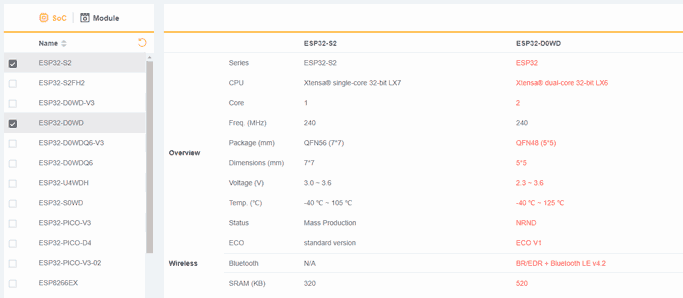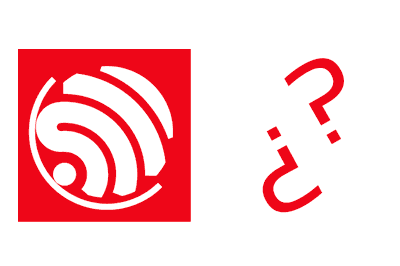If you are a technology enthusiast, you surely know about the ESP32, a low-cost, high-performance microcontroller that has become very popular in the world of robotics, IoT, and prototyping electronics. In our blog, we have frequently talked about the ESP32, presented different boards, and dedicated its own section.
However, as new versions are released, it becomes increasingly difficult to keep track of the features and differences of each model.
This is further complicated by the fact that Espressif, the company that develops the ESP32, uses not particularly clear designations to identify its products.
Additionally, it is common for people to confuse the terms processor, SoC (System on a Chip), SoM (System on a Module), and development board. This is especially problematic in the case of the ESP32, as its product range includes all four types.
To help compare and differentiate between the various ESP32 models, Espressif provides a series of comparison tools. With these tools, we can see the differences between each of the models and choose the one that best suits our needs.
Summary Comparison Table
One of them is this simple table where we can check the differences in technical features of their most popular models (ESP32, ESP32-S2, ESP32-S3, and ESP-C3), which we can find in its full version at this link
| Feature | ESP32 Series | ESP32-S2 Series | ESP32-C3 Series | ESP32-S3 Series |
|---|---|---|---|---|
| Launch year | 2016 | 2020 | 2020 | 2020 |
| Core | Xtensa® dual-/single core 32-bit LX6 | Xtensa® single-core 32-bit LX7 | 32-bit single-core RISC-V | Xtensa® dual-core 32-bit LX7 |
| Wi-Fi protocols | 802.11 b/g/n, 2.4 GHz | 802.11 b/g/n, 2.4 GHz | 802.11 b/g/n, 2.4 GHz | 802.11 b/g/n, 2.4 GHz |
| Bluetooth® | Bluetooth v4.2 and BLE | ✖️ | Bluetooth 5.0 | Bluetooth 5.0 |
| Typical frequency | 240 MHz (160 MHz for ESP32-S0WD) | 240 MHz | 160 MHz | 240 MHz |
| SRAM | 520 KB | 320 KB | 400 KB | 512 KB |
| ROM | 448 KB | 128 KB | 384 KB | 384 KB |
| External flash | Up to 16 MB device | Up to 1 GB device | Up to 16 MB device | Up to 1 GB device |
| External RAM | Up to 8 MB device | Up to 1 GB device | ✖️ | Up to 1 GB device |
| ADC | 2x 12-bit | 2x 12-bit | 2x 12-bit | 2x 12-bit |
| DAC | 2x 8-bit | 2x 8-bit | ✖️ | ✖️ |
| Timers | 4x 64-bit, 3x watchdog | 4x 64-bit, 3x watchdog | 2x 54-bit, 3x watchdog | 4x 54-bit, 3x watchdog |
| Temperature sensor | ✖️ | 1 | 1 | 1 |
| Touch sensor | 10 | 14 | ✖️ | 14 |
| Hall sensor | 1 | ✖️ | ✖️ | ✖️ |
| GPIO | 34 | 43 | 22 | 45 |
| SPI | 4 | 4 | 3 | 4 |
| LCD interface | 1 | 1 | ✖️ | 1 |
| UART | 3 | 2 | 2 | 3 |
| I2C | 2 | 2 | 1 | 2 |
| I2S | 2 | 1 | 1 | 2 |
| Camera interface | 1 | 1 | ✖️ | 1 |
| Pulse counter | 8 | 4 | ✖️ | 4 |
| LED PWM | 16 | 8 | 6 | 8 |
| SDIO follower controller | 1 | ✖️ | ✖️ | ✖️ |
| Ethernet MAC | 1 | ✖️ | ✖️ | ✖️ |
| ULP | ULP FSM | PicoRV32 8 KB SRAM, ULP FSM | ✖️ | PicoRV32 8 KB SRAM, ULP FSM |
| Deep-sleep | 100 μA | 22 μA | ✖️ | TBD |
Espressif Comparison Tool
On the other hand, Espressif’s main tool for comparing between versions of ESP32 models is the product selection webpage that we have available at this link.
Here we can choose from a dropdown all the ESP32 models, selecting both SoC and SoM products.

In the results table, we can find the main technical features of each model, including the processor model, RAM, GPIO, ADC, communication buses, among many others.
Thanks to these tools from Espressif, we can easily determine the similarities and differences between the various ESP32 models.
